International Knowledge Transfer through Expatriates: A Paradigmatic Move
VerifiedAdded on 2023/06/12
|12
|2925
|228
AI Summary
This case study discusses the challenges faced in international knowledge transfer and proposes a paradigmatic move to overcome them. It also emphasizes the role of expatriates in the knowledge transfer process.
Contribute Materials
Your contribution can guide someone’s learning journey. Share your
documents today.
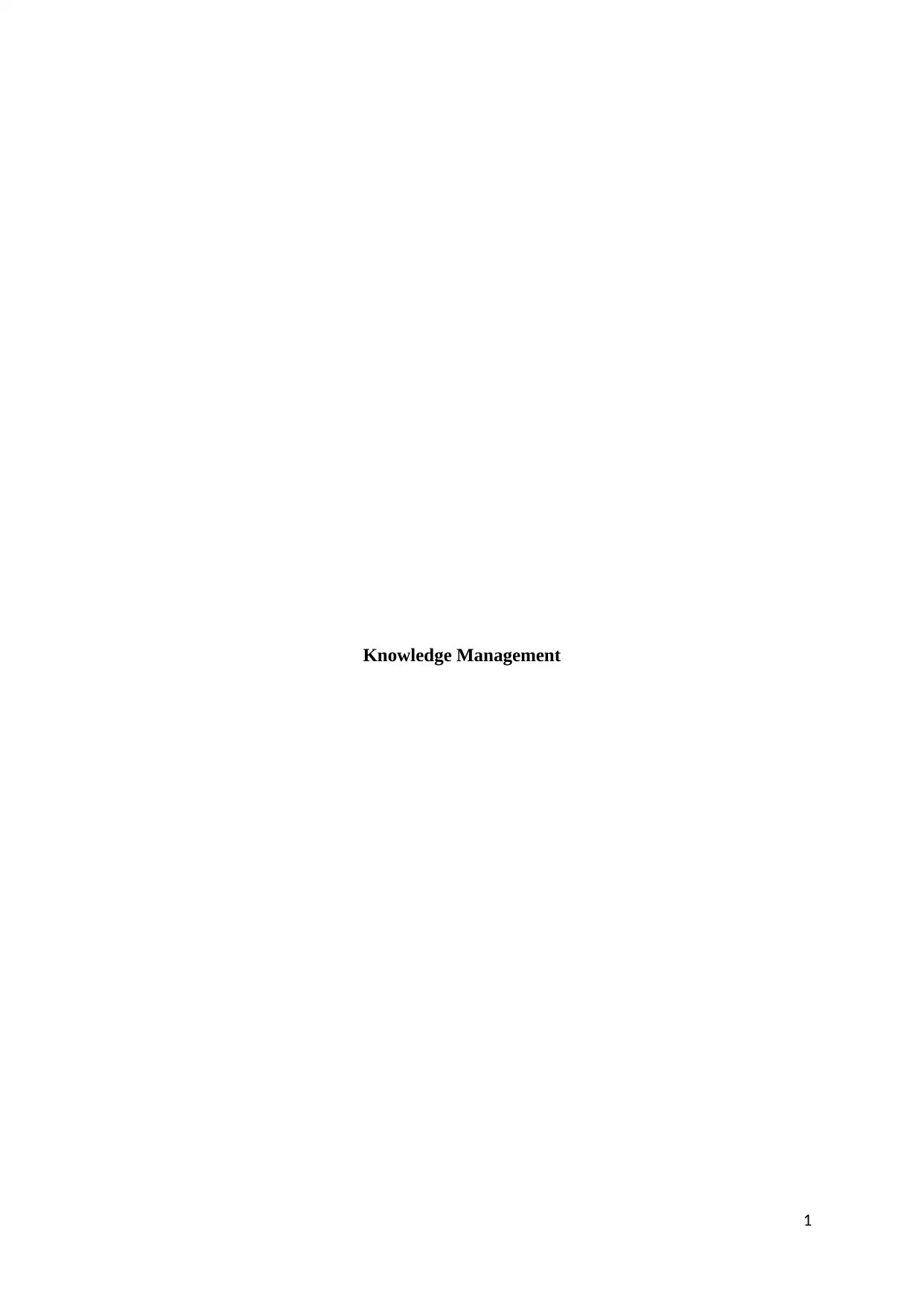
Knowledge Management
1
1
Secure Best Marks with AI Grader
Need help grading? Try our AI Grader for instant feedback on your assignments.
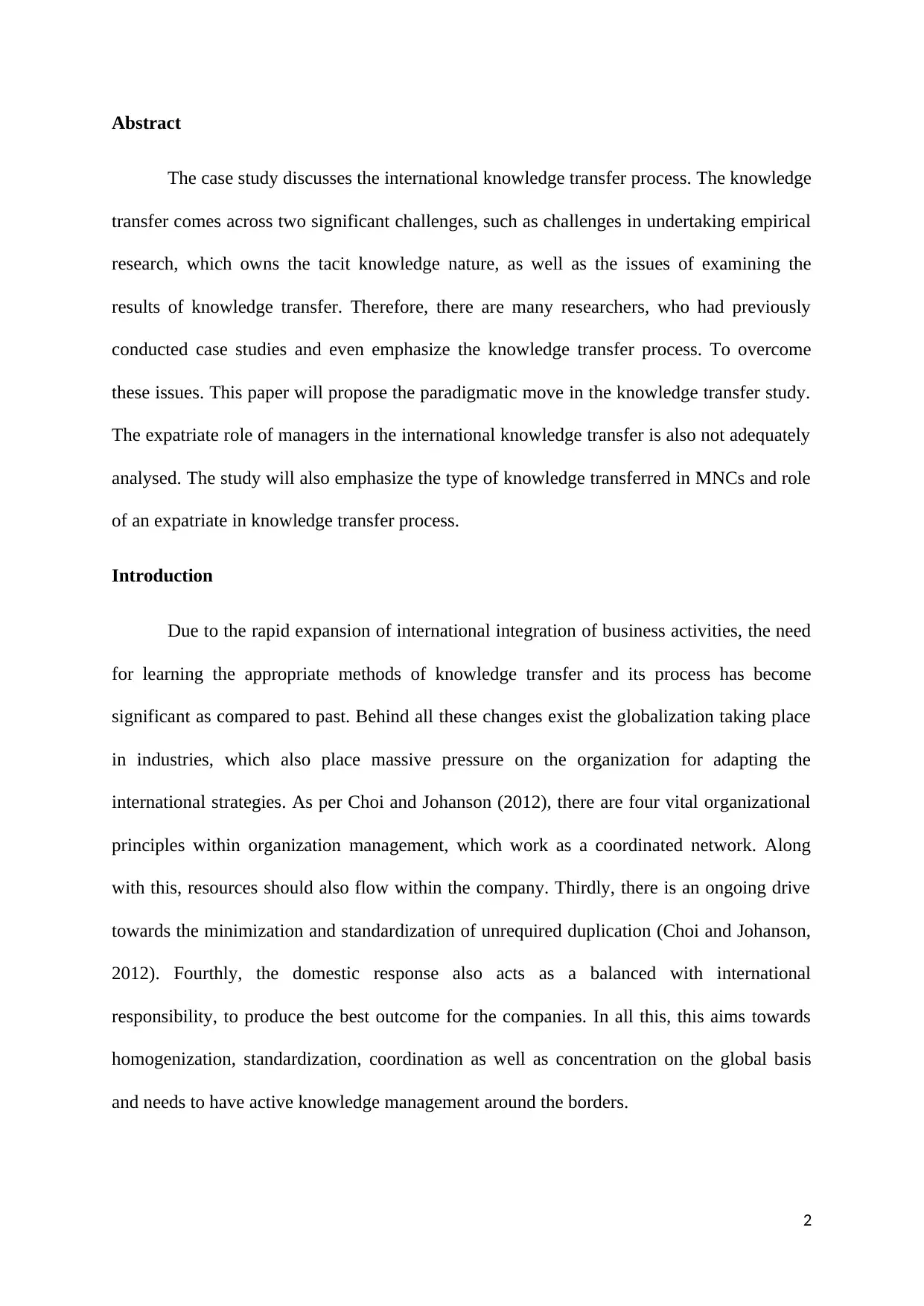
Abstract
The case study discusses the international knowledge transfer process. The knowledge
transfer comes across two significant challenges, such as challenges in undertaking empirical
research, which owns the tacit knowledge nature, as well as the issues of examining the
results of knowledge transfer. Therefore, there are many researchers, who had previously
conducted case studies and even emphasize the knowledge transfer process. To overcome
these issues. This paper will propose the paradigmatic move in the knowledge transfer study.
The expatriate role of managers in the international knowledge transfer is also not adequately
analysed. The study will also emphasize the type of knowledge transferred in MNCs and role
of an expatriate in knowledge transfer process.
Introduction
Due to the rapid expansion of international integration of business activities, the need
for learning the appropriate methods of knowledge transfer and its process has become
significant as compared to past. Behind all these changes exist the globalization taking place
in industries, which also place massive pressure on the organization for adapting the
international strategies. As per Choi and Johanson (2012), there are four vital organizational
principles within organization management, which work as a coordinated network. Along
with this, resources should also flow within the company. Thirdly, there is an ongoing drive
towards the minimization and standardization of unrequired duplication (Choi and Johanson,
2012). Fourthly, the domestic response also acts as a balanced with international
responsibility, to produce the best outcome for the companies. In all this, this aims towards
homogenization, standardization, coordination as well as concentration on the global basis
and needs to have active knowledge management around the borders.
2
The case study discusses the international knowledge transfer process. The knowledge
transfer comes across two significant challenges, such as challenges in undertaking empirical
research, which owns the tacit knowledge nature, as well as the issues of examining the
results of knowledge transfer. Therefore, there are many researchers, who had previously
conducted case studies and even emphasize the knowledge transfer process. To overcome
these issues. This paper will propose the paradigmatic move in the knowledge transfer study.
The expatriate role of managers in the international knowledge transfer is also not adequately
analysed. The study will also emphasize the type of knowledge transferred in MNCs and role
of an expatriate in knowledge transfer process.
Introduction
Due to the rapid expansion of international integration of business activities, the need
for learning the appropriate methods of knowledge transfer and its process has become
significant as compared to past. Behind all these changes exist the globalization taking place
in industries, which also place massive pressure on the organization for adapting the
international strategies. As per Choi and Johanson (2012), there are four vital organizational
principles within organization management, which work as a coordinated network. Along
with this, resources should also flow within the company. Thirdly, there is an ongoing drive
towards the minimization and standardization of unrequired duplication (Choi and Johanson,
2012). Fourthly, the domestic response also acts as a balanced with international
responsibility, to produce the best outcome for the companies. In all this, this aims towards
homogenization, standardization, coordination as well as concentration on the global basis
and needs to have active knowledge management around the borders.
2
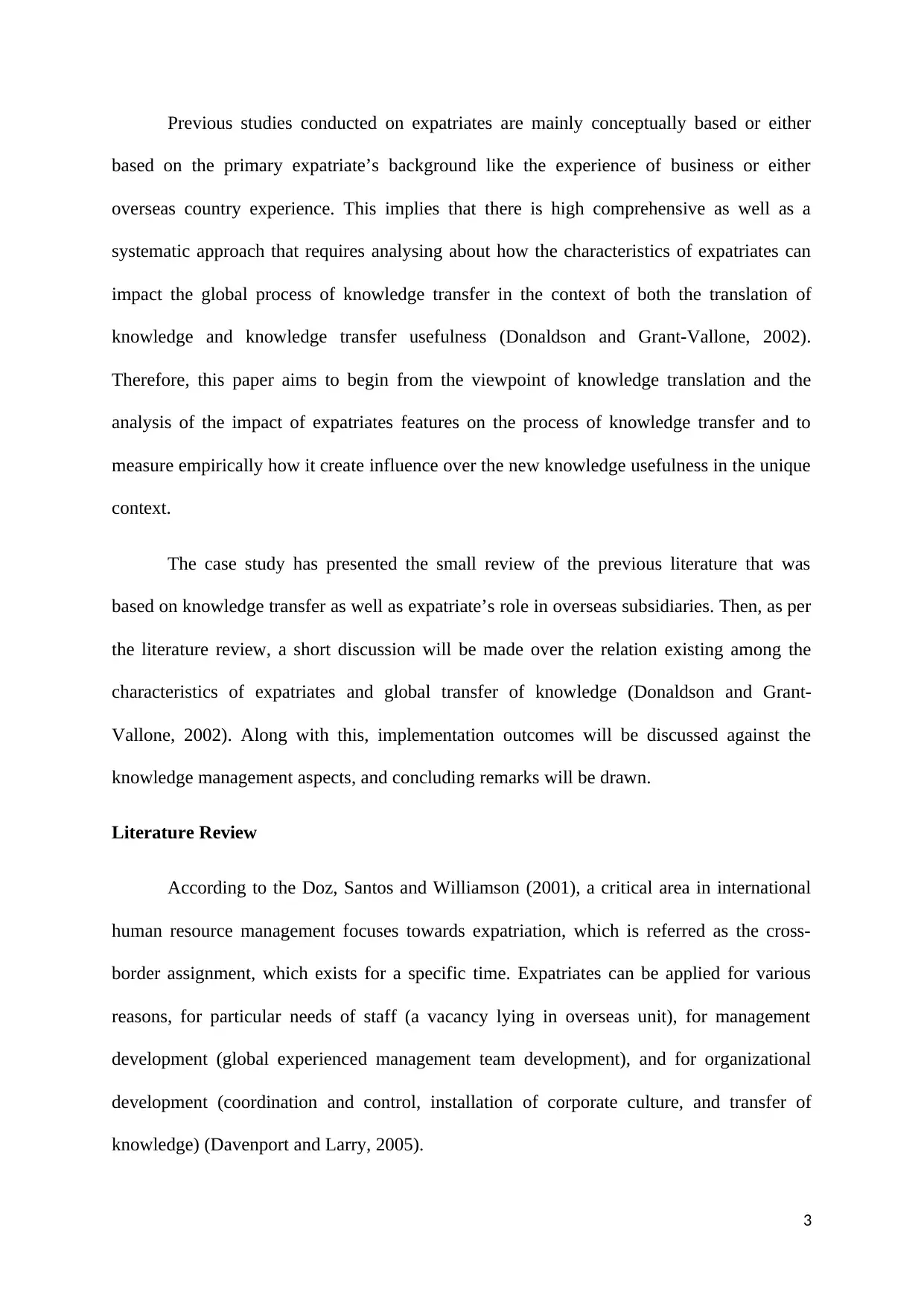
Previous studies conducted on expatriates are mainly conceptually based or either
based on the primary expatriate’s background like the experience of business or either
overseas country experience. This implies that there is high comprehensive as well as a
systematic approach that requires analysing about how the characteristics of expatriates can
impact the global process of knowledge transfer in the context of both the translation of
knowledge and knowledge transfer usefulness (Donaldson and Grant-Vallone, 2002).
Therefore, this paper aims to begin from the viewpoint of knowledge translation and the
analysis of the impact of expatriates features on the process of knowledge transfer and to
measure empirically how it create influence over the new knowledge usefulness in the unique
context.
The case study has presented the small review of the previous literature that was
based on knowledge transfer as well as expatriate’s role in overseas subsidiaries. Then, as per
the literature review, a short discussion will be made over the relation existing among the
characteristics of expatriates and global transfer of knowledge (Donaldson and Grant-
Vallone, 2002). Along with this, implementation outcomes will be discussed against the
knowledge management aspects, and concluding remarks will be drawn.
Literature Review
According to the Doz, Santos and Williamson (2001), a critical area in international
human resource management focuses towards expatriation, which is referred as the cross-
border assignment, which exists for a specific time. Expatriates can be applied for various
reasons, for particular needs of staff (a vacancy lying in overseas unit), for management
development (global experienced management team development), and for organizational
development (coordination and control, installation of corporate culture, and transfer of
knowledge) (Davenport and Larry, 2005).
3
based on the primary expatriate’s background like the experience of business or either
overseas country experience. This implies that there is high comprehensive as well as a
systematic approach that requires analysing about how the characteristics of expatriates can
impact the global process of knowledge transfer in the context of both the translation of
knowledge and knowledge transfer usefulness (Donaldson and Grant-Vallone, 2002).
Therefore, this paper aims to begin from the viewpoint of knowledge translation and the
analysis of the impact of expatriates features on the process of knowledge transfer and to
measure empirically how it create influence over the new knowledge usefulness in the unique
context.
The case study has presented the small review of the previous literature that was
based on knowledge transfer as well as expatriate’s role in overseas subsidiaries. Then, as per
the literature review, a short discussion will be made over the relation existing among the
characteristics of expatriates and global transfer of knowledge (Donaldson and Grant-
Vallone, 2002). Along with this, implementation outcomes will be discussed against the
knowledge management aspects, and concluding remarks will be drawn.
Literature Review
According to the Doz, Santos and Williamson (2001), a critical area in international
human resource management focuses towards expatriation, which is referred as the cross-
border assignment, which exists for a specific time. Expatriates can be applied for various
reasons, for particular needs of staff (a vacancy lying in overseas unit), for management
development (global experienced management team development), and for organizational
development (coordination and control, installation of corporate culture, and transfer of
knowledge) (Davenport and Larry, 2005).
3
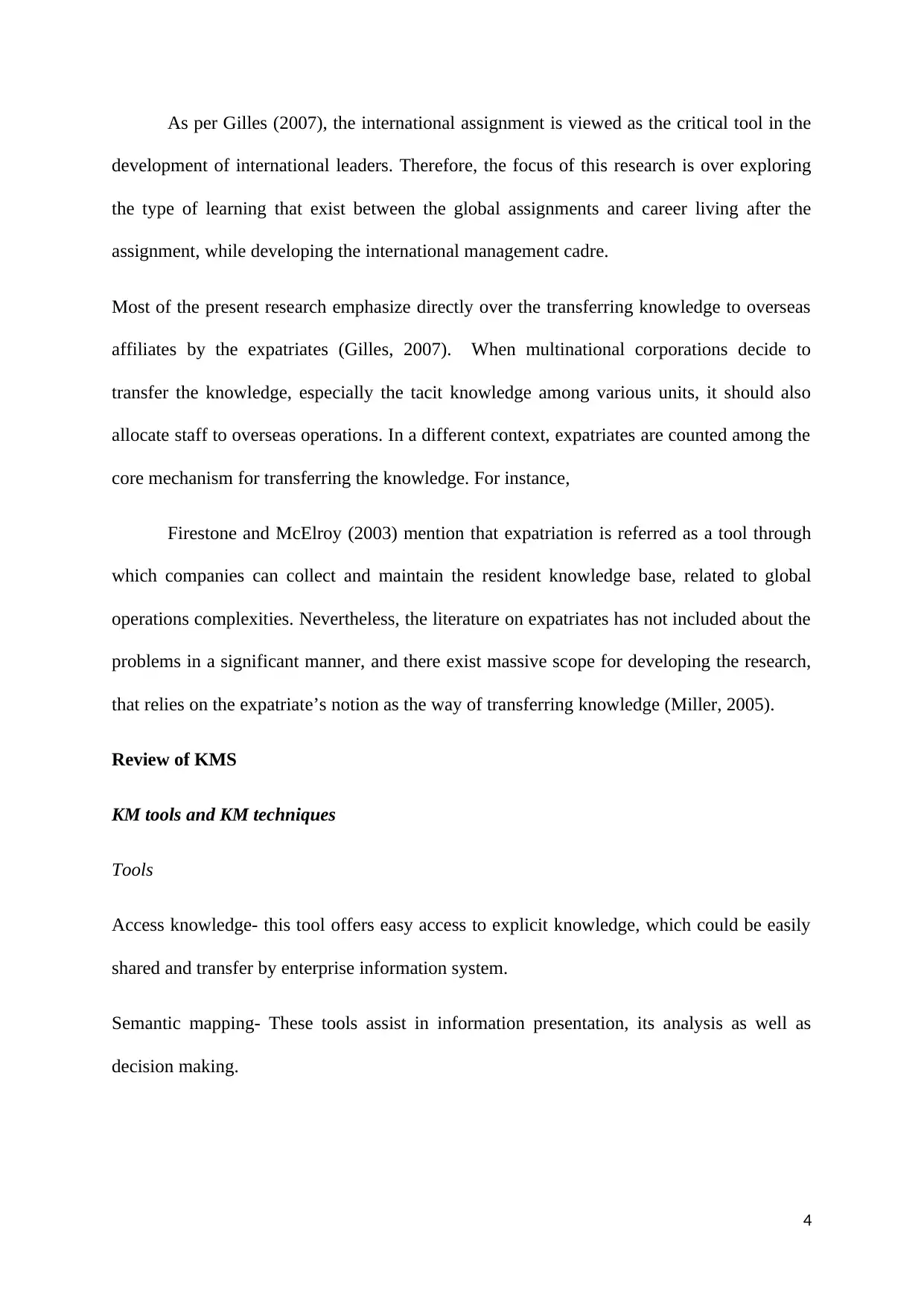
As per Gilles (2007), the international assignment is viewed as the critical tool in the
development of international leaders. Therefore, the focus of this research is over exploring
the type of learning that exist between the global assignments and career living after the
assignment, while developing the international management cadre.
Most of the present research emphasize directly over the transferring knowledge to overseas
affiliates by the expatriates (Gilles, 2007). When multinational corporations decide to
transfer the knowledge, especially the tacit knowledge among various units, it should also
allocate staff to overseas operations. In a different context, expatriates are counted among the
core mechanism for transferring the knowledge. For instance,
Firestone and McElroy (2003) mention that expatriation is referred as a tool through
which companies can collect and maintain the resident knowledge base, related to global
operations complexities. Nevertheless, the literature on expatriates has not included about the
problems in a significant manner, and there exist massive scope for developing the research,
that relies on the expatriate’s notion as the way of transferring knowledge (Miller, 2005).
Review of KMS
KM tools and KM techniques
Tools
Access knowledge- this tool offers easy access to explicit knowledge, which could be easily
shared and transfer by enterprise information system.
Semantic mapping- These tools assist in information presentation, its analysis as well as
decision making.
4
development of international leaders. Therefore, the focus of this research is over exploring
the type of learning that exist between the global assignments and career living after the
assignment, while developing the international management cadre.
Most of the present research emphasize directly over the transferring knowledge to overseas
affiliates by the expatriates (Gilles, 2007). When multinational corporations decide to
transfer the knowledge, especially the tacit knowledge among various units, it should also
allocate staff to overseas operations. In a different context, expatriates are counted among the
core mechanism for transferring the knowledge. For instance,
Firestone and McElroy (2003) mention that expatriation is referred as a tool through
which companies can collect and maintain the resident knowledge base, related to global
operations complexities. Nevertheless, the literature on expatriates has not included about the
problems in a significant manner, and there exist massive scope for developing the research,
that relies on the expatriate’s notion as the way of transferring knowledge (Miller, 2005).
Review of KMS
KM tools and KM techniques
Tools
Access knowledge- this tool offers easy access to explicit knowledge, which could be easily
shared and transfer by enterprise information system.
Semantic mapping- These tools assist in information presentation, its analysis as well as
decision making.
4
Secure Best Marks with AI Grader
Need help grading? Try our AI Grader for instant feedback on your assignments.
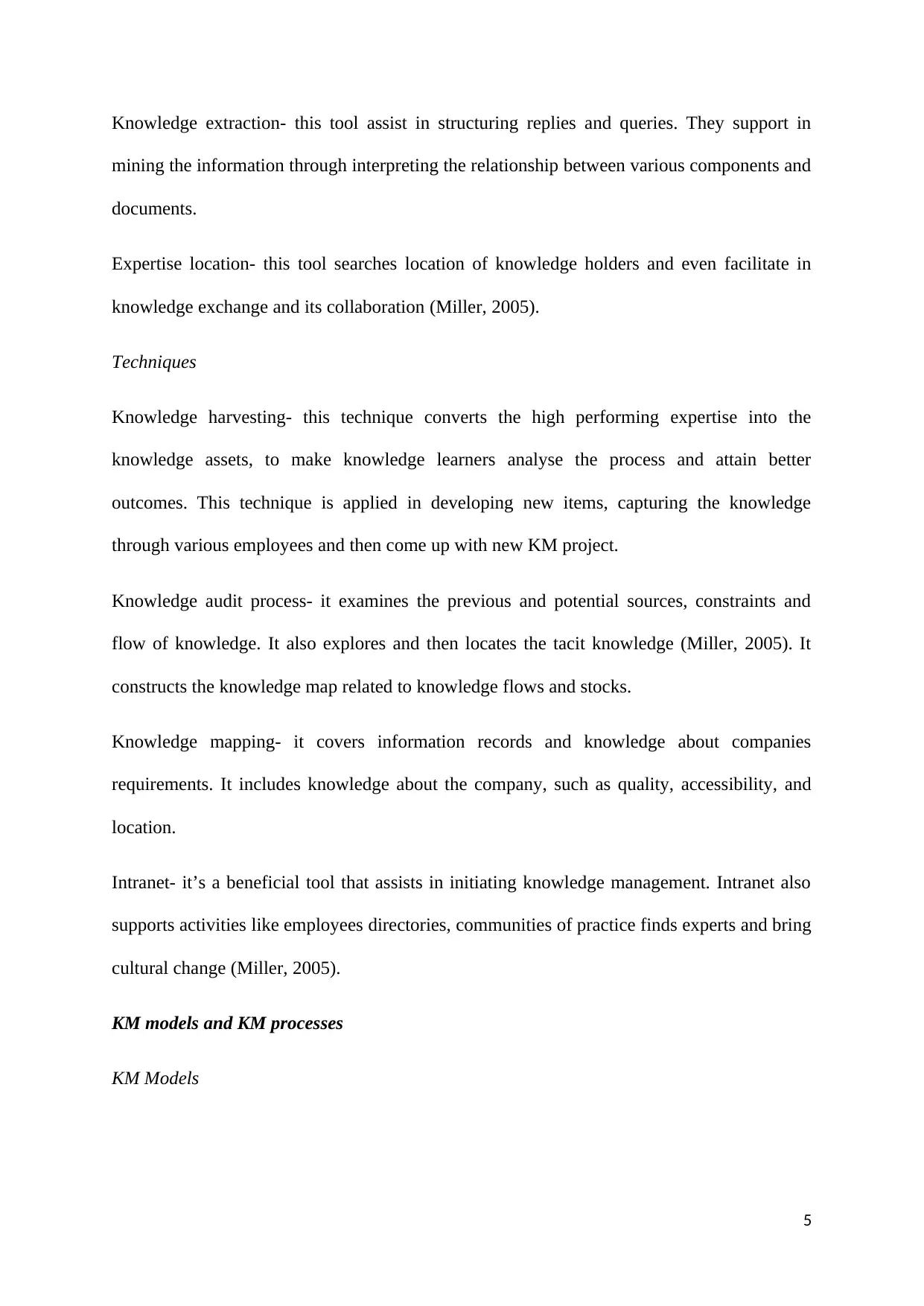
Knowledge extraction- this tool assist in structuring replies and queries. They support in
mining the information through interpreting the relationship between various components and
documents.
Expertise location- this tool searches location of knowledge holders and even facilitate in
knowledge exchange and its collaboration (Miller, 2005).
Techniques
Knowledge harvesting- this technique converts the high performing expertise into the
knowledge assets, to make knowledge learners analyse the process and attain better
outcomes. This technique is applied in developing new items, capturing the knowledge
through various employees and then come up with new KM project.
Knowledge audit process- it examines the previous and potential sources, constraints and
flow of knowledge. It also explores and then locates the tacit knowledge (Miller, 2005). It
constructs the knowledge map related to knowledge flows and stocks.
Knowledge mapping- it covers information records and knowledge about companies
requirements. It includes knowledge about the company, such as quality, accessibility, and
location.
Intranet- it’s a beneficial tool that assists in initiating knowledge management. Intranet also
supports activities like employees directories, communities of practice finds experts and bring
cultural change (Miller, 2005).
KM models and KM processes
KM Models
5
mining the information through interpreting the relationship between various components and
documents.
Expertise location- this tool searches location of knowledge holders and even facilitate in
knowledge exchange and its collaboration (Miller, 2005).
Techniques
Knowledge harvesting- this technique converts the high performing expertise into the
knowledge assets, to make knowledge learners analyse the process and attain better
outcomes. This technique is applied in developing new items, capturing the knowledge
through various employees and then come up with new KM project.
Knowledge audit process- it examines the previous and potential sources, constraints and
flow of knowledge. It also explores and then locates the tacit knowledge (Miller, 2005). It
constructs the knowledge map related to knowledge flows and stocks.
Knowledge mapping- it covers information records and knowledge about companies
requirements. It includes knowledge about the company, such as quality, accessibility, and
location.
Intranet- it’s a beneficial tool that assists in initiating knowledge management. Intranet also
supports activities like employees directories, communities of practice finds experts and bring
cultural change (Miller, 2005).
KM models and KM processes
KM Models
5
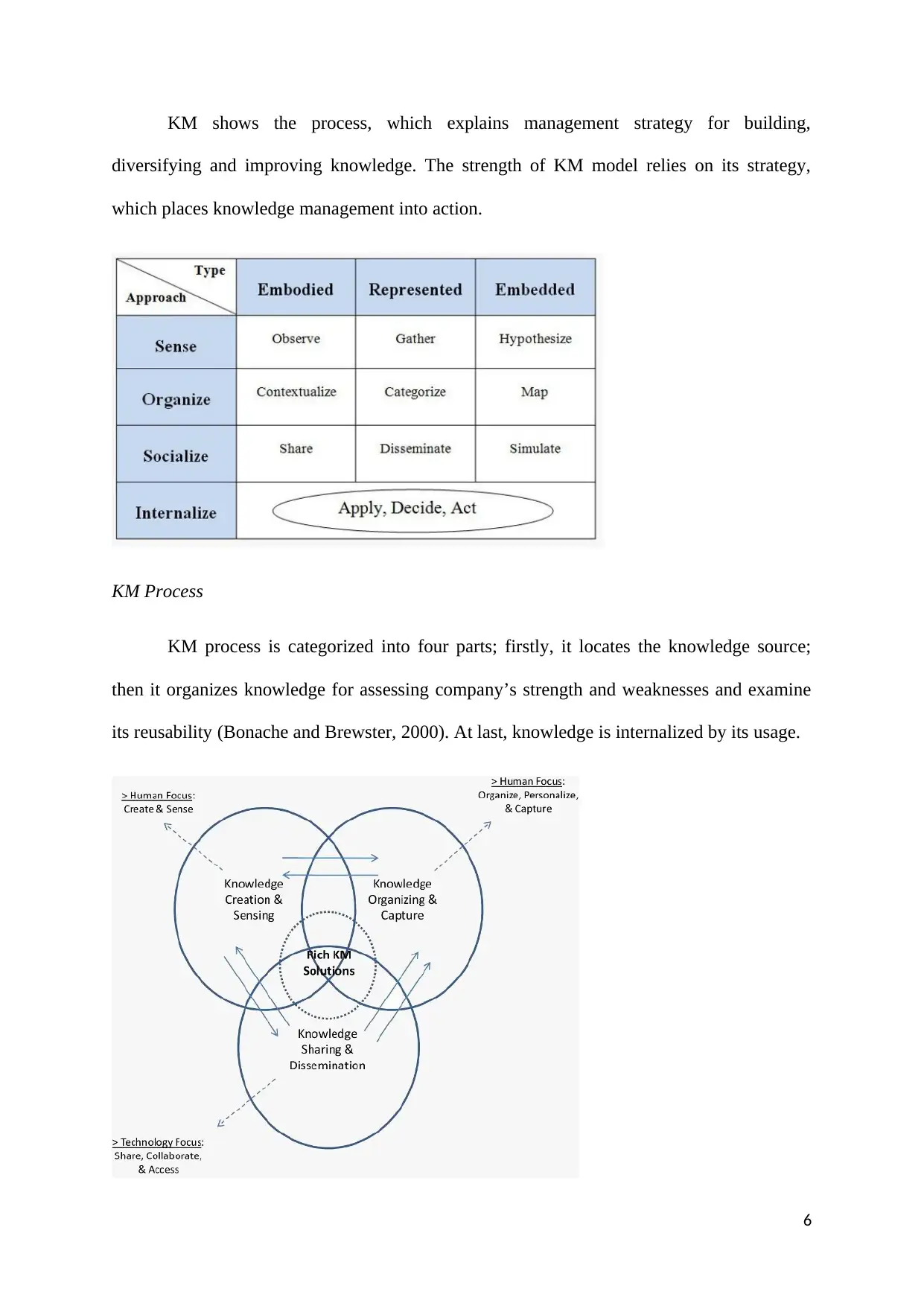
KM shows the process, which explains management strategy for building,
diversifying and improving knowledge. The strength of KM model relies on its strategy,
which places knowledge management into action.
KM Process
KM process is categorized into four parts; firstly, it locates the knowledge source;
then it organizes knowledge for assessing company’s strength and weaknesses and examine
its reusability (Bonache and Brewster, 2000). At last, knowledge is internalized by its usage.
6
diversifying and improving knowledge. The strength of KM model relies on its strategy,
which places knowledge management into action.
KM Process
KM process is categorized into four parts; firstly, it locates the knowledge source;
then it organizes knowledge for assessing company’s strength and weaknesses and examine
its reusability (Bonache and Brewster, 2000). At last, knowledge is internalized by its usage.
6
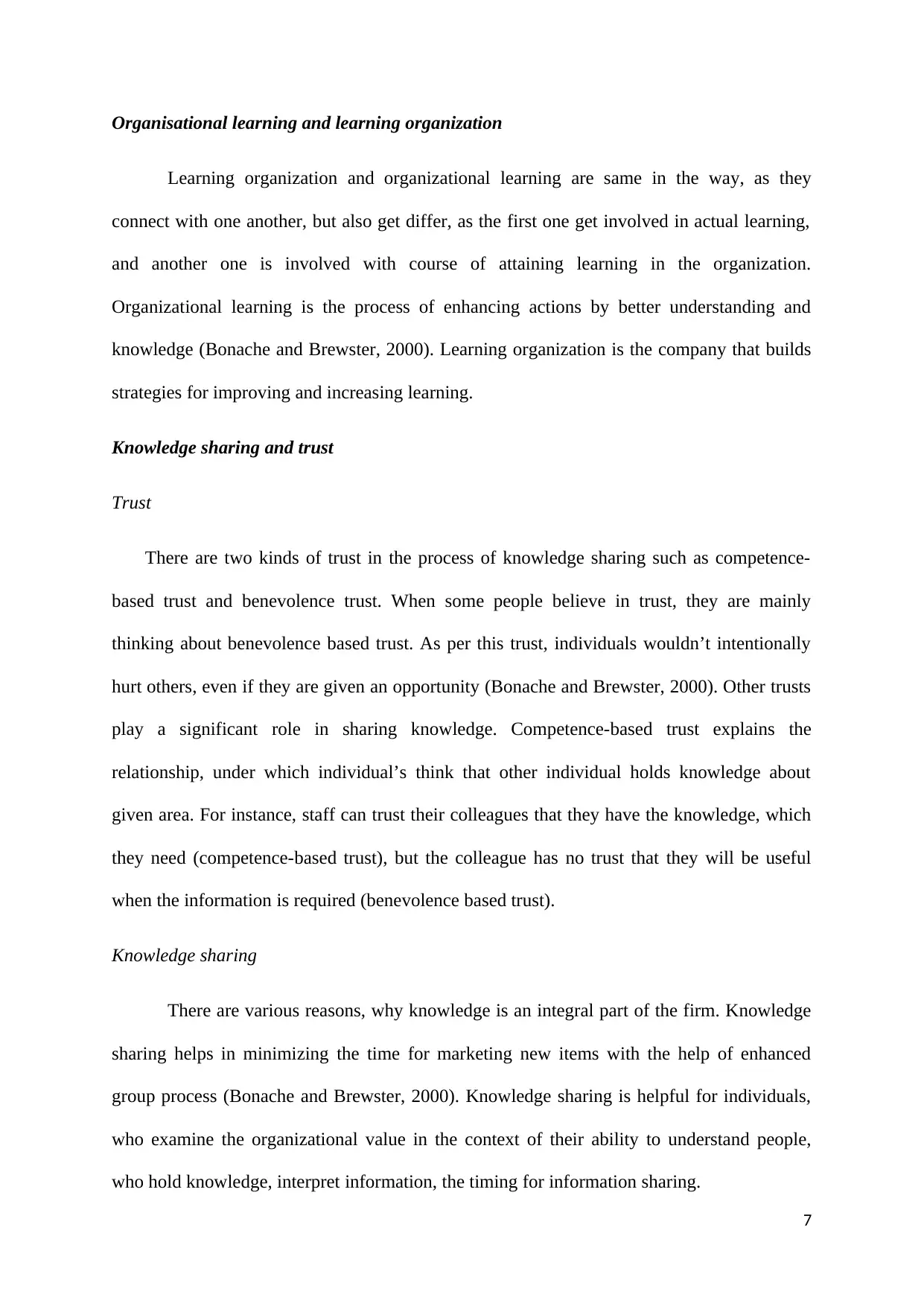
Organisational learning and learning organization
Learning organization and organizational learning are same in the way, as they
connect with one another, but also get differ, as the first one get involved in actual learning,
and another one is involved with course of attaining learning in the organization.
Organizational learning is the process of enhancing actions by better understanding and
knowledge (Bonache and Brewster, 2000). Learning organization is the company that builds
strategies for improving and increasing learning.
Knowledge sharing and trust
Trust
There are two kinds of trust in the process of knowledge sharing such as competence-
based trust and benevolence trust. When some people believe in trust, they are mainly
thinking about benevolence based trust. As per this trust, individuals wouldn’t intentionally
hurt others, even if they are given an opportunity (Bonache and Brewster, 2000). Other trusts
play a significant role in sharing knowledge. Competence-based trust explains the
relationship, under which individual’s think that other individual holds knowledge about
given area. For instance, staff can trust their colleagues that they have the knowledge, which
they need (competence-based trust), but the colleague has no trust that they will be useful
when the information is required (benevolence based trust).
Knowledge sharing
There are various reasons, why knowledge is an integral part of the firm. Knowledge
sharing helps in minimizing the time for marketing new items with the help of enhanced
group process (Bonache and Brewster, 2000). Knowledge sharing is helpful for individuals,
who examine the organizational value in the context of their ability to understand people,
who hold knowledge, interpret information, the timing for information sharing.
7
Learning organization and organizational learning are same in the way, as they
connect with one another, but also get differ, as the first one get involved in actual learning,
and another one is involved with course of attaining learning in the organization.
Organizational learning is the process of enhancing actions by better understanding and
knowledge (Bonache and Brewster, 2000). Learning organization is the company that builds
strategies for improving and increasing learning.
Knowledge sharing and trust
Trust
There are two kinds of trust in the process of knowledge sharing such as competence-
based trust and benevolence trust. When some people believe in trust, they are mainly
thinking about benevolence based trust. As per this trust, individuals wouldn’t intentionally
hurt others, even if they are given an opportunity (Bonache and Brewster, 2000). Other trusts
play a significant role in sharing knowledge. Competence-based trust explains the
relationship, under which individual’s think that other individual holds knowledge about
given area. For instance, staff can trust their colleagues that they have the knowledge, which
they need (competence-based trust), but the colleague has no trust that they will be useful
when the information is required (benevolence based trust).
Knowledge sharing
There are various reasons, why knowledge is an integral part of the firm. Knowledge
sharing helps in minimizing the time for marketing new items with the help of enhanced
group process (Bonache and Brewster, 2000). Knowledge sharing is helpful for individuals,
who examine the organizational value in the context of their ability to understand people,
who hold knowledge, interpret information, the timing for information sharing.
7
Paraphrase This Document
Need a fresh take? Get an instant paraphrase of this document with our AI Paraphraser
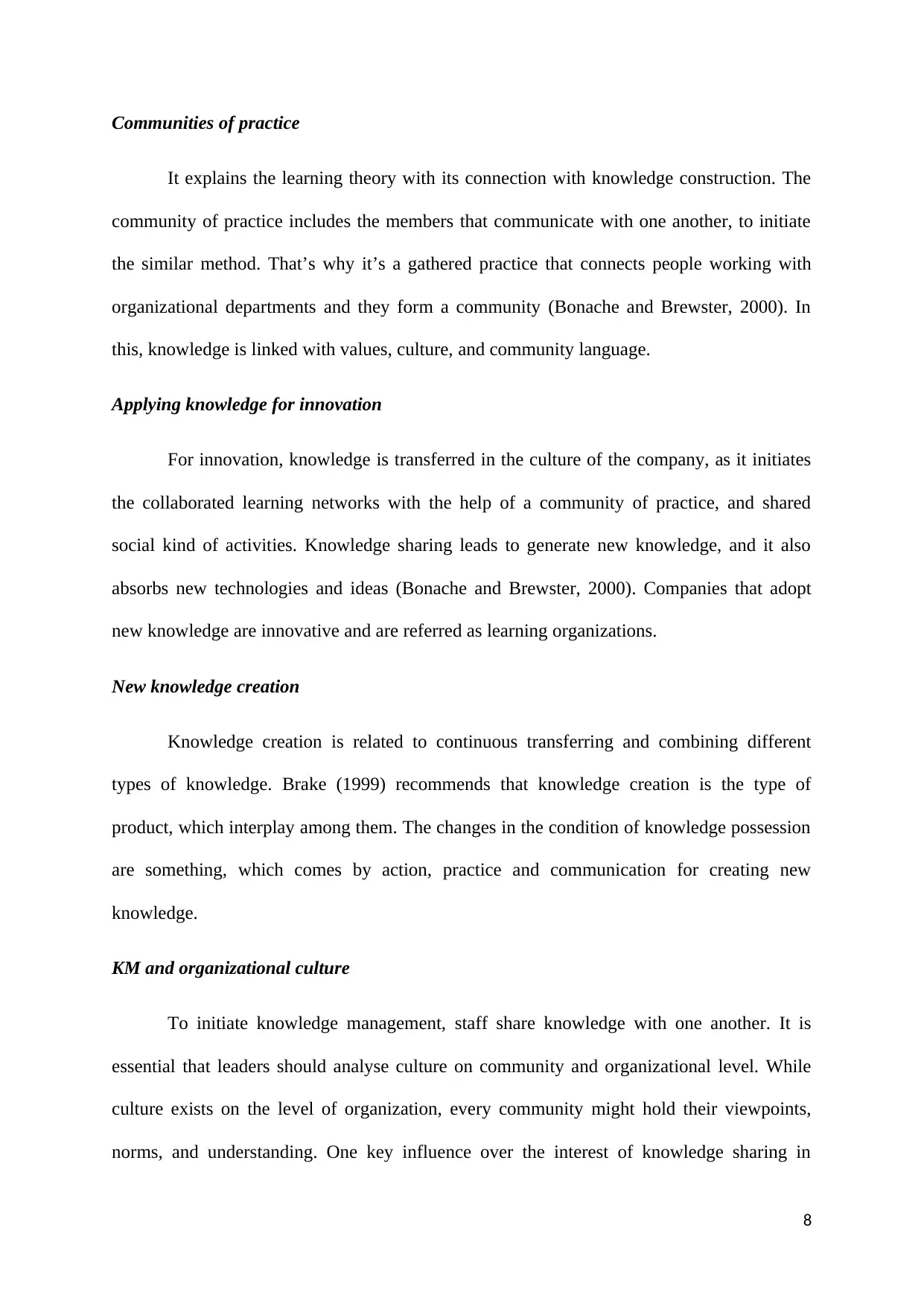
Communities of practice
It explains the learning theory with its connection with knowledge construction. The
community of practice includes the members that communicate with one another, to initiate
the similar method. That’s why it’s a gathered practice that connects people working with
organizational departments and they form a community (Bonache and Brewster, 2000). In
this, knowledge is linked with values, culture, and community language.
Applying knowledge for innovation
For innovation, knowledge is transferred in the culture of the company, as it initiates
the collaborated learning networks with the help of a community of practice, and shared
social kind of activities. Knowledge sharing leads to generate new knowledge, and it also
absorbs new technologies and ideas (Bonache and Brewster, 2000). Companies that adopt
new knowledge are innovative and are referred as learning organizations.
New knowledge creation
Knowledge creation is related to continuous transferring and combining different
types of knowledge. Brake (1999) recommends that knowledge creation is the type of
product, which interplay among them. The changes in the condition of knowledge possession
are something, which comes by action, practice and communication for creating new
knowledge.
KM and organizational culture
To initiate knowledge management, staff share knowledge with one another. It is
essential that leaders should analyse culture on community and organizational level. While
culture exists on the level of organization, every community might hold their viewpoints,
norms, and understanding. One key influence over the interest of knowledge sharing in
8
It explains the learning theory with its connection with knowledge construction. The
community of practice includes the members that communicate with one another, to initiate
the similar method. That’s why it’s a gathered practice that connects people working with
organizational departments and they form a community (Bonache and Brewster, 2000). In
this, knowledge is linked with values, culture, and community language.
Applying knowledge for innovation
For innovation, knowledge is transferred in the culture of the company, as it initiates
the collaborated learning networks with the help of a community of practice, and shared
social kind of activities. Knowledge sharing leads to generate new knowledge, and it also
absorbs new technologies and ideas (Bonache and Brewster, 2000). Companies that adopt
new knowledge are innovative and are referred as learning organizations.
New knowledge creation
Knowledge creation is related to continuous transferring and combining different
types of knowledge. Brake (1999) recommends that knowledge creation is the type of
product, which interplay among them. The changes in the condition of knowledge possession
are something, which comes by action, practice and communication for creating new
knowledge.
KM and organizational culture
To initiate knowledge management, staff share knowledge with one another. It is
essential that leaders should analyse culture on community and organizational level. While
culture exists on the level of organization, every community might hold their viewpoints,
norms, and understanding. One key influence over the interest of knowledge sharing in
8
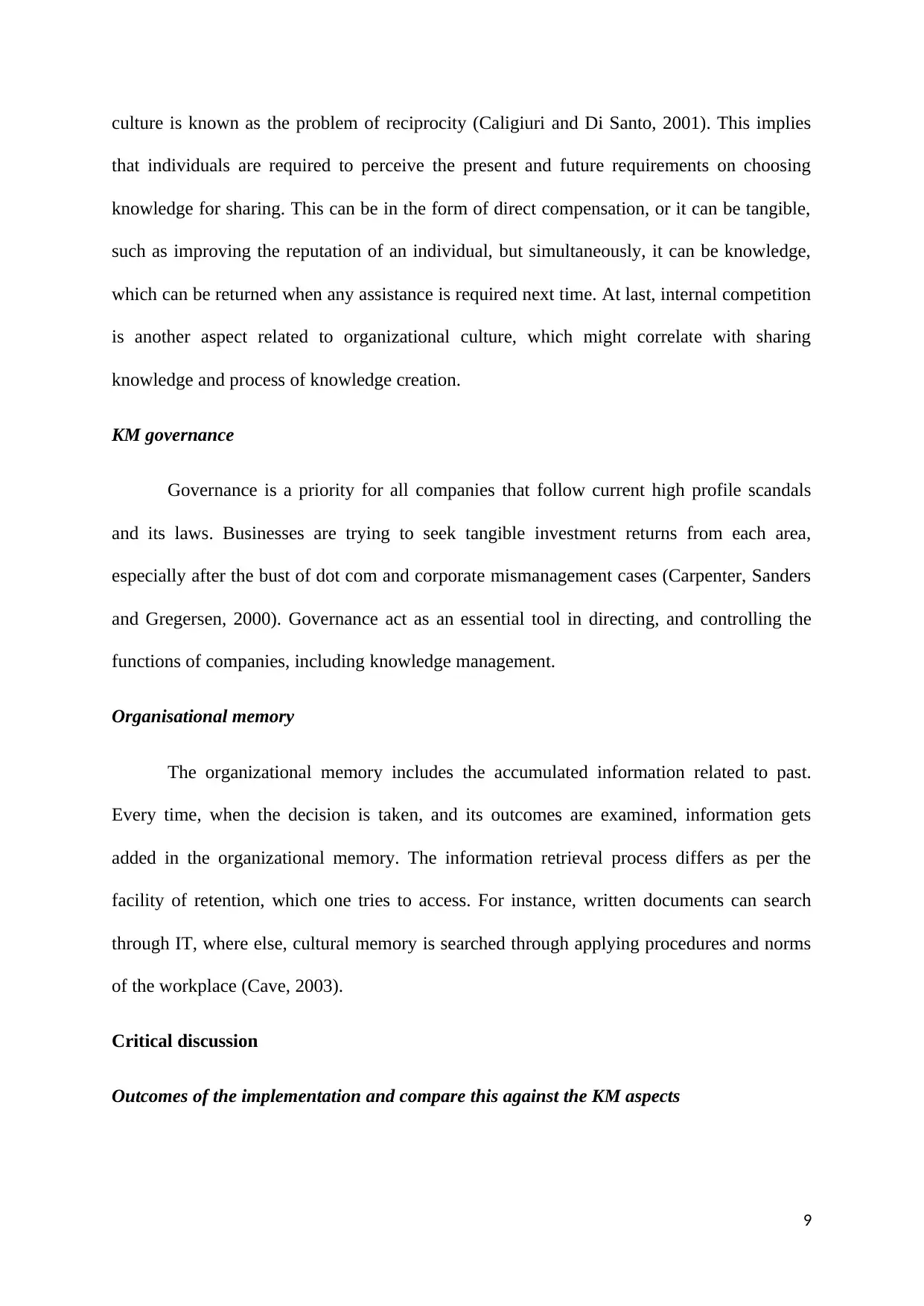
culture is known as the problem of reciprocity (Caligiuri and Di Santo, 2001). This implies
that individuals are required to perceive the present and future requirements on choosing
knowledge for sharing. This can be in the form of direct compensation, or it can be tangible,
such as improving the reputation of an individual, but simultaneously, it can be knowledge,
which can be returned when any assistance is required next time. At last, internal competition
is another aspect related to organizational culture, which might correlate with sharing
knowledge and process of knowledge creation.
KM governance
Governance is a priority for all companies that follow current high profile scandals
and its laws. Businesses are trying to seek tangible investment returns from each area,
especially after the bust of dot com and corporate mismanagement cases (Carpenter, Sanders
and Gregersen, 2000). Governance act as an essential tool in directing, and controlling the
functions of companies, including knowledge management.
Organisational memory
The organizational memory includes the accumulated information related to past.
Every time, when the decision is taken, and its outcomes are examined, information gets
added in the organizational memory. The information retrieval process differs as per the
facility of retention, which one tries to access. For instance, written documents can search
through IT, where else, cultural memory is searched through applying procedures and norms
of the workplace (Cave, 2003).
Critical discussion
Outcomes of the implementation and compare this against the KM aspects
9
that individuals are required to perceive the present and future requirements on choosing
knowledge for sharing. This can be in the form of direct compensation, or it can be tangible,
such as improving the reputation of an individual, but simultaneously, it can be knowledge,
which can be returned when any assistance is required next time. At last, internal competition
is another aspect related to organizational culture, which might correlate with sharing
knowledge and process of knowledge creation.
KM governance
Governance is a priority for all companies that follow current high profile scandals
and its laws. Businesses are trying to seek tangible investment returns from each area,
especially after the bust of dot com and corporate mismanagement cases (Carpenter, Sanders
and Gregersen, 2000). Governance act as an essential tool in directing, and controlling the
functions of companies, including knowledge management.
Organisational memory
The organizational memory includes the accumulated information related to past.
Every time, when the decision is taken, and its outcomes are examined, information gets
added in the organizational memory. The information retrieval process differs as per the
facility of retention, which one tries to access. For instance, written documents can search
through IT, where else, cultural memory is searched through applying procedures and norms
of the workplace (Cave, 2003).
Critical discussion
Outcomes of the implementation and compare this against the KM aspects
9
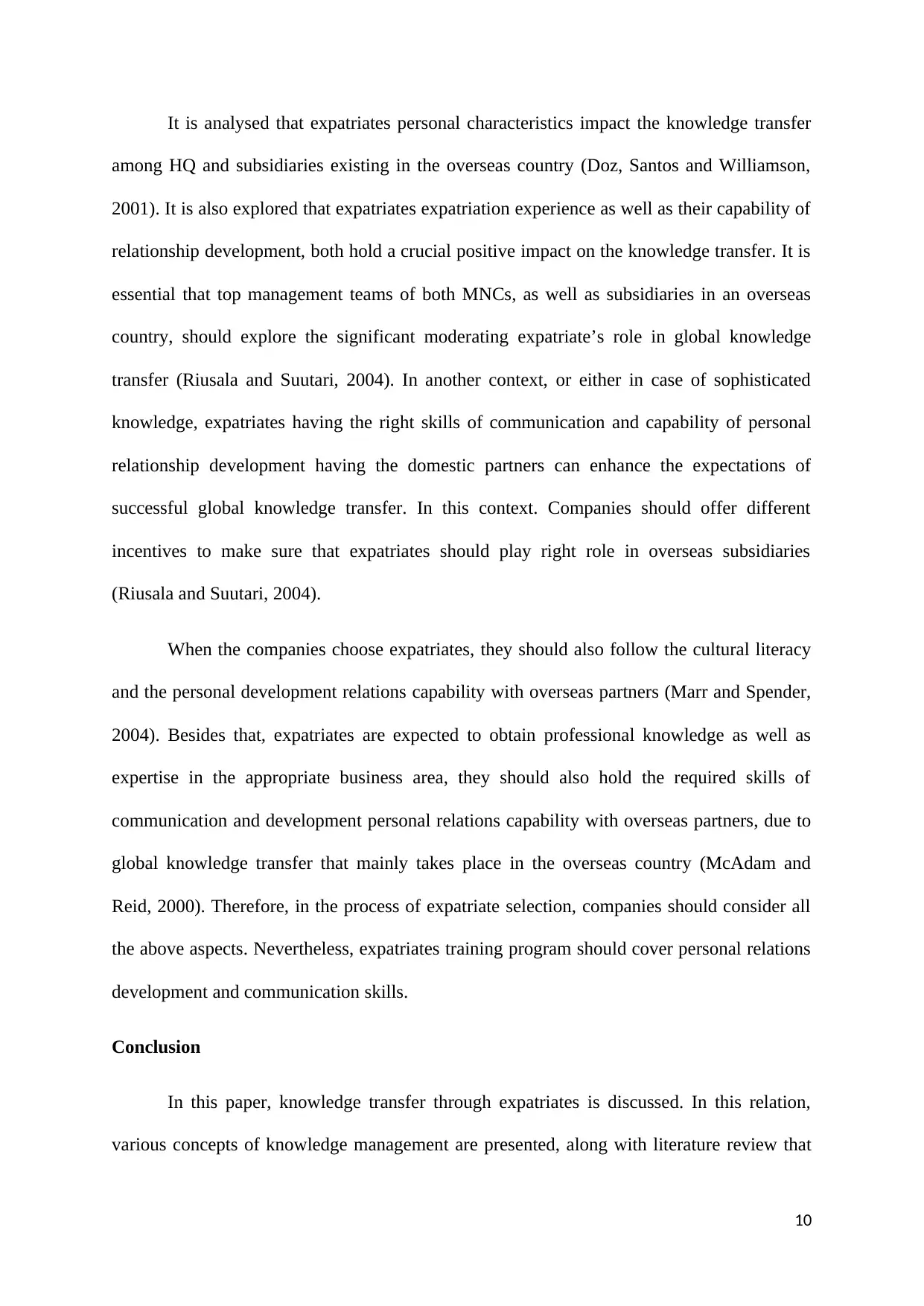
It is analysed that expatriates personal characteristics impact the knowledge transfer
among HQ and subsidiaries existing in the overseas country (Doz, Santos and Williamson,
2001). It is also explored that expatriates expatriation experience as well as their capability of
relationship development, both hold a crucial positive impact on the knowledge transfer. It is
essential that top management teams of both MNCs, as well as subsidiaries in an overseas
country, should explore the significant moderating expatriate’s role in global knowledge
transfer (Riusala and Suutari, 2004). In another context, or either in case of sophisticated
knowledge, expatriates having the right skills of communication and capability of personal
relationship development having the domestic partners can enhance the expectations of
successful global knowledge transfer. In this context. Companies should offer different
incentives to make sure that expatriates should play right role in overseas subsidiaries
(Riusala and Suutari, 2004).
When the companies choose expatriates, they should also follow the cultural literacy
and the personal development relations capability with overseas partners (Marr and Spender,
2004). Besides that, expatriates are expected to obtain professional knowledge as well as
expertise in the appropriate business area, they should also hold the required skills of
communication and development personal relations capability with overseas partners, due to
global knowledge transfer that mainly takes place in the overseas country (McAdam and
Reid, 2000). Therefore, in the process of expatriate selection, companies should consider all
the above aspects. Nevertheless, expatriates training program should cover personal relations
development and communication skills.
Conclusion
In this paper, knowledge transfer through expatriates is discussed. In this relation,
various concepts of knowledge management are presented, along with literature review that
10
among HQ and subsidiaries existing in the overseas country (Doz, Santos and Williamson,
2001). It is also explored that expatriates expatriation experience as well as their capability of
relationship development, both hold a crucial positive impact on the knowledge transfer. It is
essential that top management teams of both MNCs, as well as subsidiaries in an overseas
country, should explore the significant moderating expatriate’s role in global knowledge
transfer (Riusala and Suutari, 2004). In another context, or either in case of sophisticated
knowledge, expatriates having the right skills of communication and capability of personal
relationship development having the domestic partners can enhance the expectations of
successful global knowledge transfer. In this context. Companies should offer different
incentives to make sure that expatriates should play right role in overseas subsidiaries
(Riusala and Suutari, 2004).
When the companies choose expatriates, they should also follow the cultural literacy
and the personal development relations capability with overseas partners (Marr and Spender,
2004). Besides that, expatriates are expected to obtain professional knowledge as well as
expertise in the appropriate business area, they should also hold the required skills of
communication and development personal relations capability with overseas partners, due to
global knowledge transfer that mainly takes place in the overseas country (McAdam and
Reid, 2000). Therefore, in the process of expatriate selection, companies should consider all
the above aspects. Nevertheless, expatriates training program should cover personal relations
development and communication skills.
Conclusion
In this paper, knowledge transfer through expatriates is discussed. In this relation,
various concepts of knowledge management are presented, along with literature review that
10
Secure Best Marks with AI Grader
Need help grading? Try our AI Grader for instant feedback on your assignments.
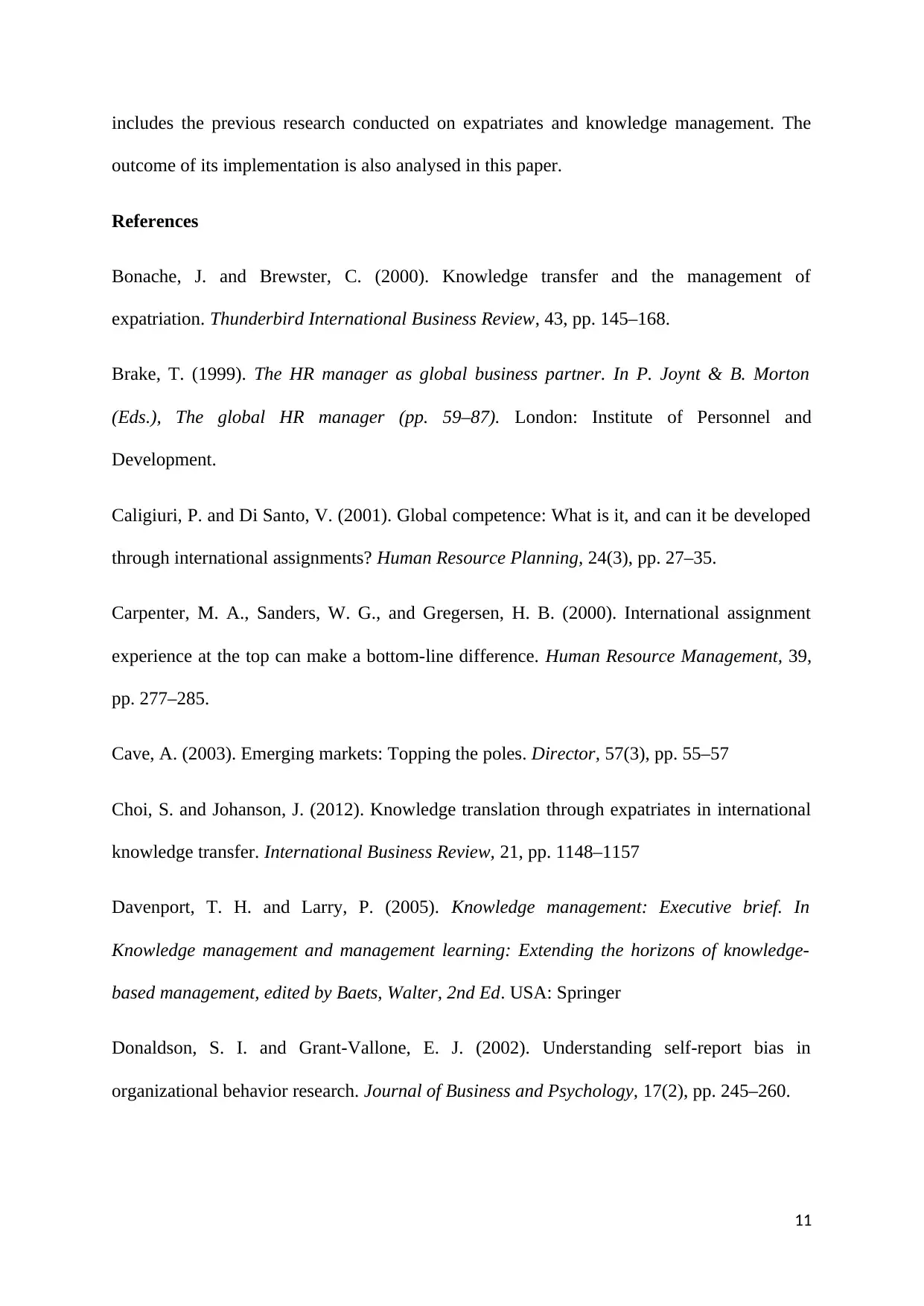
includes the previous research conducted on expatriates and knowledge management. The
outcome of its implementation is also analysed in this paper.
References
Bonache, J. and Brewster, C. (2000). Knowledge transfer and the management of
expatriation. Thunderbird International Business Review, 43, pp. 145–168.
Brake, T. (1999). The HR manager as global business partner. In P. Joynt & B. Morton
(Eds.), The global HR manager (pp. 59–87). London: Institute of Personnel and
Development.
Caligiuri, P. and Di Santo, V. (2001). Global competence: What is it, and can it be developed
through international assignments? Human Resource Planning, 24(3), pp. 27–35.
Carpenter, M. A., Sanders, W. G., and Gregersen, H. B. (2000). International assignment
experience at the top can make a bottom-line difference. Human Resource Management, 39,
pp. 277–285.
Cave, A. (2003). Emerging markets: Topping the poles. Director, 57(3), pp. 55–57
Choi, S. and Johanson, J. (2012). Knowledge translation through expatriates in international
knowledge transfer. International Business Review, 21, pp. 1148–1157
Davenport, T. H. and Larry, P. (2005). Knowledge management: Executive brief. In
Knowledge management and management learning: Extending the horizons of knowledge-
based management, edited by Baets, Walter, 2nd Ed. USA: Springer
Donaldson, S. I. and Grant-Vallone, E. J. (2002). Understanding self-report bias in
organizational behavior research. Journal of Business and Psychology, 17(2), pp. 245–260.
11
outcome of its implementation is also analysed in this paper.
References
Bonache, J. and Brewster, C. (2000). Knowledge transfer and the management of
expatriation. Thunderbird International Business Review, 43, pp. 145–168.
Brake, T. (1999). The HR manager as global business partner. In P. Joynt & B. Morton
(Eds.), The global HR manager (pp. 59–87). London: Institute of Personnel and
Development.
Caligiuri, P. and Di Santo, V. (2001). Global competence: What is it, and can it be developed
through international assignments? Human Resource Planning, 24(3), pp. 27–35.
Carpenter, M. A., Sanders, W. G., and Gregersen, H. B. (2000). International assignment
experience at the top can make a bottom-line difference. Human Resource Management, 39,
pp. 277–285.
Cave, A. (2003). Emerging markets: Topping the poles. Director, 57(3), pp. 55–57
Choi, S. and Johanson, J. (2012). Knowledge translation through expatriates in international
knowledge transfer. International Business Review, 21, pp. 1148–1157
Davenport, T. H. and Larry, P. (2005). Knowledge management: Executive brief. In
Knowledge management and management learning: Extending the horizons of knowledge-
based management, edited by Baets, Walter, 2nd Ed. USA: Springer
Donaldson, S. I. and Grant-Vallone, E. J. (2002). Understanding self-report bias in
organizational behavior research. Journal of Business and Psychology, 17(2), pp. 245–260.
11
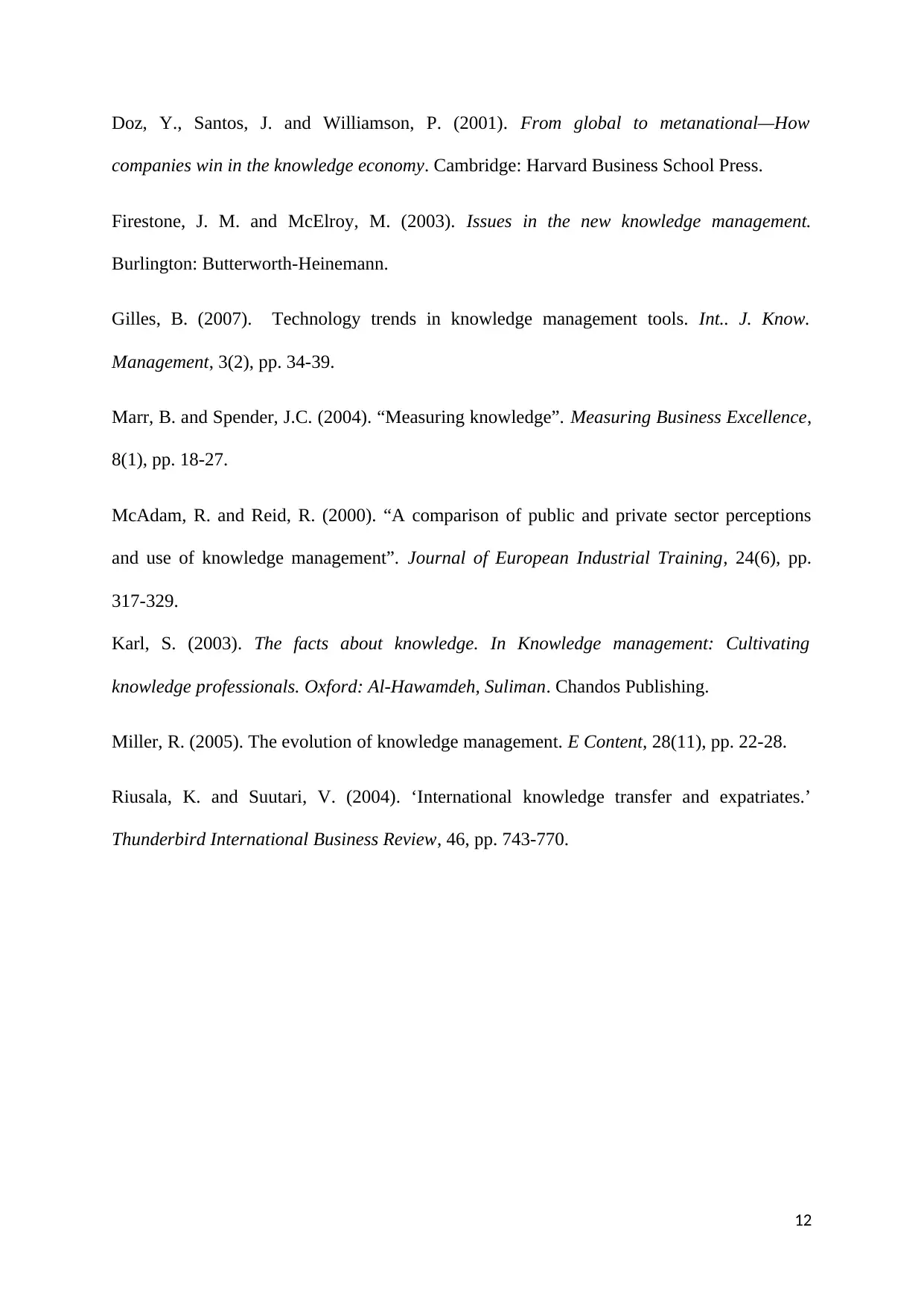
Doz, Y., Santos, J. and Williamson, P. (2001). From global to metanational—How
companies win in the knowledge economy. Cambridge: Harvard Business School Press.
Firestone, J. M. and McElroy, M. (2003). Issues in the new knowledge management.
Burlington: Butterworth-Heinemann.
Gilles, B. (2007). Technology trends in knowledge management tools. Int.. J. Know.
Management, 3(2), pp. 34-39.
Marr, B. and Spender, J.C. (2004). “Measuring knowledge”. Measuring Business Excellence,
8(1), pp. 18-27.
McAdam, R. and Reid, R. (2000). “A comparison of public and private sector perceptions
and use of knowledge management”. Journal of European Industrial Training, 24(6), pp.
317-329.
Karl, S. (2003). The facts about knowledge. In Knowledge management: Cultivating
knowledge professionals. Oxford: Al-Hawamdeh, Suliman. Chandos Publishing.
Miller, R. (2005). The evolution of knowledge management. E Content, 28(11), pp. 22-28.
Riusala, K. and Suutari, V. (2004). ‘International knowledge transfer and expatriates.’
Thunderbird International Business Review, 46, pp. 743-770.
12
companies win in the knowledge economy. Cambridge: Harvard Business School Press.
Firestone, J. M. and McElroy, M. (2003). Issues in the new knowledge management.
Burlington: Butterworth-Heinemann.
Gilles, B. (2007). Technology trends in knowledge management tools. Int.. J. Know.
Management, 3(2), pp. 34-39.
Marr, B. and Spender, J.C. (2004). “Measuring knowledge”. Measuring Business Excellence,
8(1), pp. 18-27.
McAdam, R. and Reid, R. (2000). “A comparison of public and private sector perceptions
and use of knowledge management”. Journal of European Industrial Training, 24(6), pp.
317-329.
Karl, S. (2003). The facts about knowledge. In Knowledge management: Cultivating
knowledge professionals. Oxford: Al-Hawamdeh, Suliman. Chandos Publishing.
Miller, R. (2005). The evolution of knowledge management. E Content, 28(11), pp. 22-28.
Riusala, K. and Suutari, V. (2004). ‘International knowledge transfer and expatriates.’
Thunderbird International Business Review, 46, pp. 743-770.
12
1 out of 12
Related Documents
Your All-in-One AI-Powered Toolkit for Academic Success.
+13062052269
info@desklib.com
Available 24*7 on WhatsApp / Email
![[object Object]](/_next/static/media/star-bottom.7253800d.svg)
Unlock your academic potential
© 2024 | Zucol Services PVT LTD | All rights reserved.




